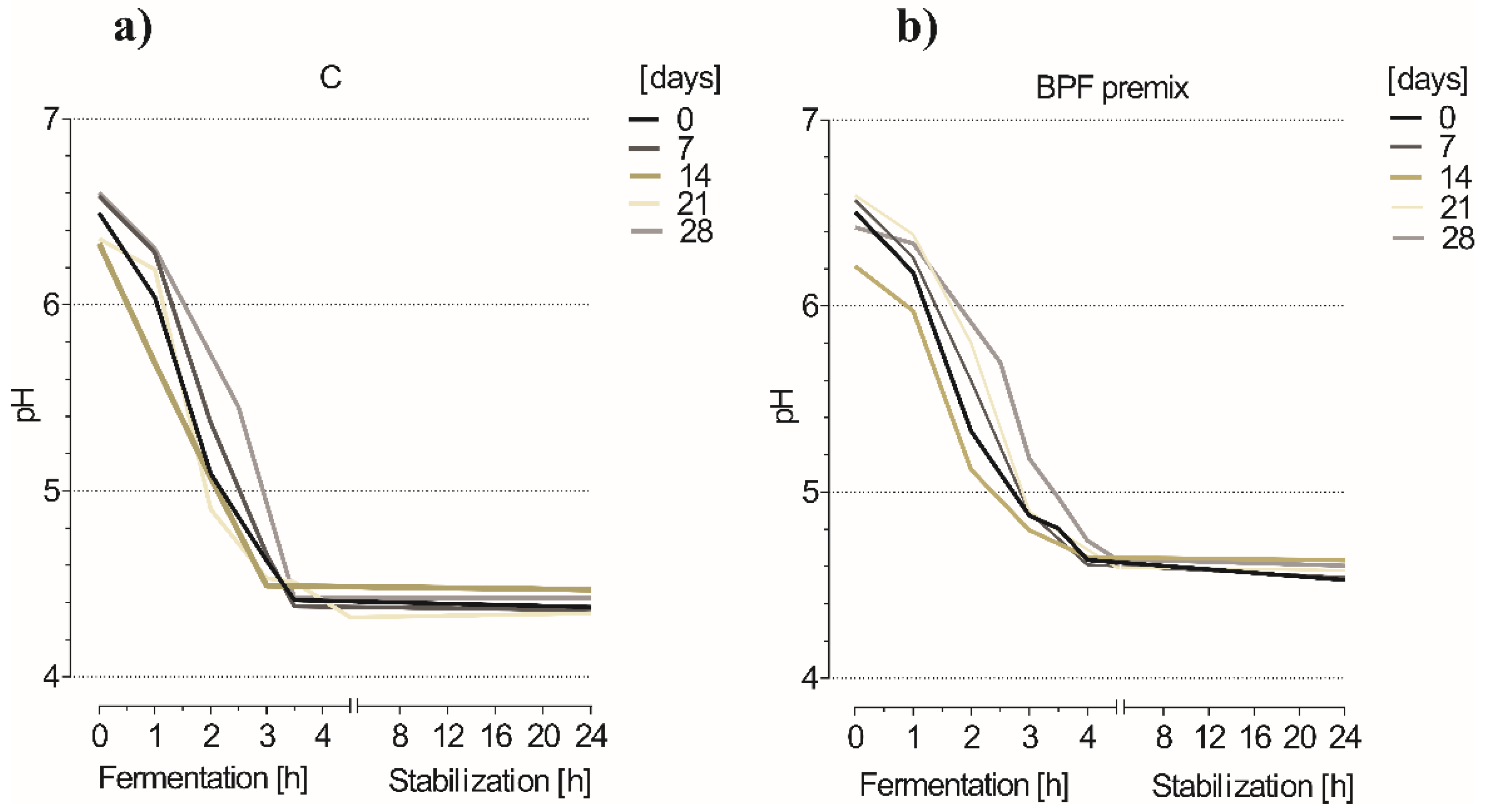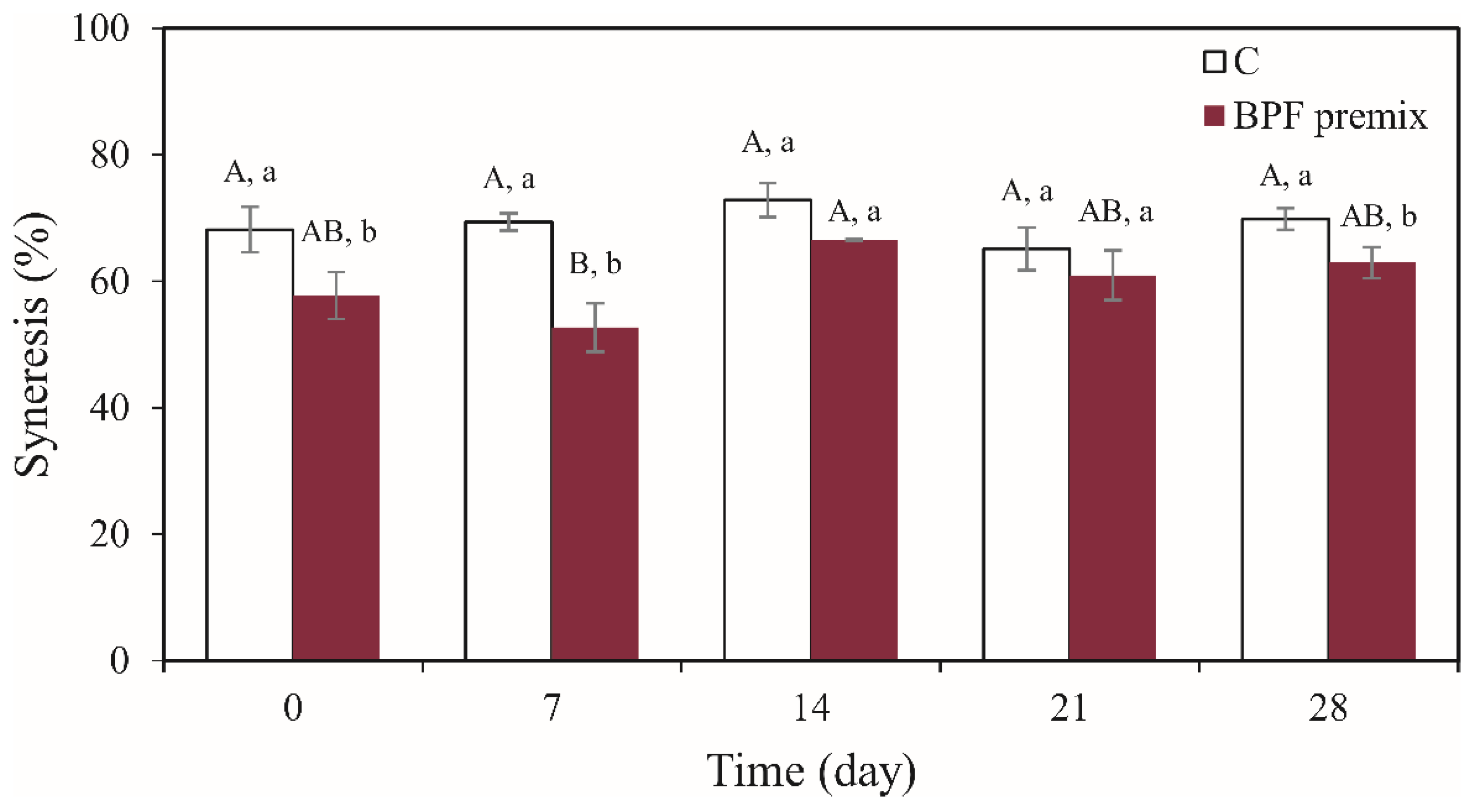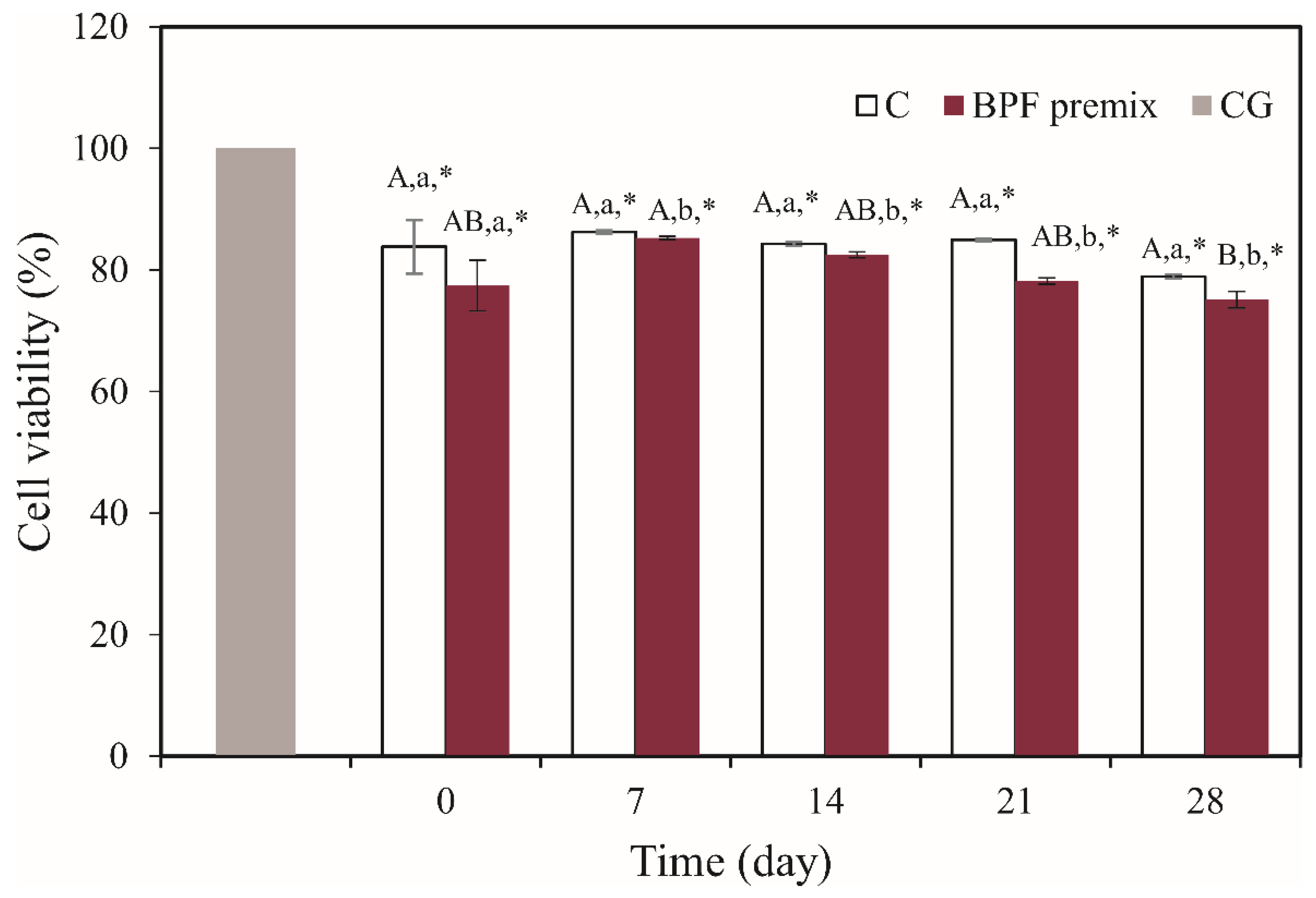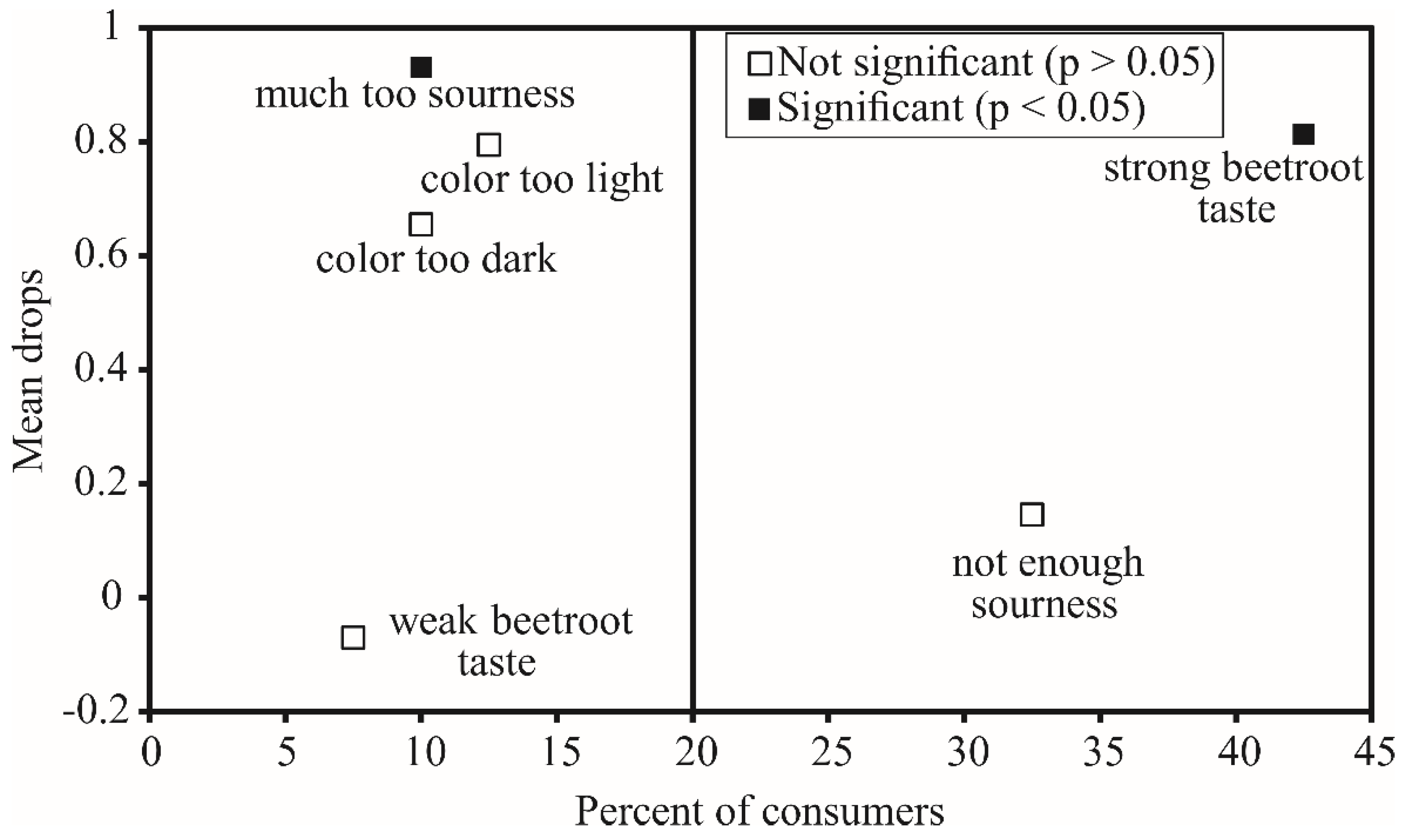Functionality and Palatability of Yogurt Produced Using Beetroot Pomace Flour Granulated with Lactic Acid Bacteria
Abstract
:1. Introduction
2. Materials and Methods
2.1. Materials
2.2. Beetroot Pomace Flour Preparation and Characterization
2.3. Batch Granulation of BPF by Fluidized Bed at Pilot-Scale Level
2.4. Determination of Physical and Technological Properties of BPF before and after Granulation
2.4.1. The Flowability
2.4.2. Particle Size Distribution
2.4.3. Water Activity
2.5. Evaluation of Granulated BPF Toxicity
2.6. Application of Granulated BPF as a Premix in Yogurt Production
2.6.1. Production of Yogurt at Laboratory Scale Level
2.6.2. Syneresis of Yogurt Samples
2.7. Determination of Functionality of Yogurt Produced Using Granulated BPF as Premix
2.7.1. LAB Viability
2.7.2. In Situ Antibacterial Activity
2.7.3. Cytotoxicity
2.8. Yogurt Palatability Assessment
2.8.1. Trial with Humans—JAR Test
2.8.2. Trial with Dogs—The Two-Bowl Test
2.9. Surveying of Consumers’ Attitude towards Novel Product and Accompanied Concept
2.10. Statistical Analysis
3. Results and Discussion
3.1. Production and Proximate Composition of BPF
3.2. Granulation of BPF with LAB Using the Fluidized Bed Technique
3.3. Physical and Technological Properties of BPF before and after Granulation
3.3.1. Flowability
3.3.2. Particle Size Distribution
3.3.3. Storability of Non-Granulated and Granulated BPF
3.4. Evaluation of Granulated BPF Toxicity
3.5. Application of Granulated BPF as Premix for Yogurt Production
Influence of BPF Premix on Yogurt pH and Syneresis
3.6. Functionality of Yogurt Prepared Using Granulated BPF as a Premix
3.6.1. Bacterial Viability
3.6.2. In Situ Anti-Escherichia Activity
3.6.3. Cytotoxic Properties
3.7. Palatability Study
3.7.1. Trial with Human Panelists
3.7.2. Feeding Trial with Dogs
3.8. Consumers Attitude Survey
4. Conclusions
5. Patents
Supplementary Materials
Author Contributions
Funding
Institutional Review Board Statement
Informed Consent Statement
Data Availability Statement
Acknowledgments
Conflicts of Interest
References
- OECD/FAO. OECD-FAO Guidance for Responsible Agricultural Supply Chains; OECD Publishing: Paris, France, 2016. [Google Scholar]
- Schebesta, H.; Candel, J.J. Game-changing potential of the EU’s Farm to Fork Strategy. Nat. Food 2020, 1, 586–588. [Google Scholar] [CrossRef]
- Kok, K.P.; Den Boer, A.C.; Cesuroglu, T.; Van Der Meij, M.G.; de Wildt-Liesveld, R.; Regeer, B.J.; Broerse, J.E. Transforming Research and Innovation for Sustainable Food Systems—A Coupled-Systems Perspective. Sustainability 2019, 11, 7176. [Google Scholar] [CrossRef] [Green Version]
- Clifford, T.; Howatson, G.; West, D.J.; Stevenson, E.J. The potential benefits of red beetroot supplementation in health and disease. Nutrients 2015, 7, 2801–2822. [Google Scholar] [CrossRef]
- Kohajdová, Z.; Karovičová, J.; Kuchtová, V.; Lauková, M. Utilisation of beetroot powder for bakery applications. Chem. Pap. 2018, 72, 1507–1515. [Google Scholar] [CrossRef]
- De Godoy, M.R.; Kerr, K.R.; Fahey, G.C., Jr. Alternative dietary fiber sources in companion animal nutrition. Nutrients 2013, 5, 3099–3117. [Google Scholar] [CrossRef]
- Vulić, J.; Čanadanović-Brunet, J.; Ćetković, G.; Tumbas, V.; Djilas, S.; Četojević-Simin, D.; Čanadanović, V. Antioxidant and cell growth activities of beet root pomace extracts. J. Funct. Foods 2012, 4, 670–678. [Google Scholar] [CrossRef]
- Tumbas Šaponjac, V.; Čanadanović-Brunet, J.; Ćetković, G.; Jakišić, M.; Djilas, S.; Vulić, J.; Stajčić, S. Encapsulation of beetroot pomace extract: RSM optimization, storage and gastrointestinal stability. Molecules 2016, 21, 584. [Google Scholar] [CrossRef]
- Wadhwa, M.; Bakshi, M.P.S.; Makkar, H.P.S. Wastes to worth: Value added products from fruit and vegetable wastes. CAB Int. 2015, 43, 1–25. [Google Scholar] [CrossRef]
- Baião, D.D.S.; da Silva, D.V.; Paschoalin, V.M. Beetroot, a Remarkable Vegetable: Its Nitrate and Phytochemical Contents Can be Adjusted in Novel Formulations to Benefit Health and Support Cardiovascular Disease Therapies. Antioxidants 2020, 9, 960. [Google Scholar] [CrossRef]
- Barbu, V.; Cotârleț, M.; Bolea, C.A.; Cantaragiu, A.; Andronoiu, D.G.; Bahrim, G.E.; Enachi, E. Three Types of Beetroot Products Enriched with Lactic Acid Bacteria. Foods 2020, 9, 786. [Google Scholar] [CrossRef]
- Cano-Lamadrid, M.; Tkacz, K.; Turkiewicz, I.P.; Clemente-Villalba, J.; Sánchez-Rodríguez, L.; Lipan, L.; García-García, E.; Carbonell-Barrachina, Á.A.; Wojdyło, A. How a Spanish Group of Millennial Generation Perceives the Commercial Novel Smoothies? Foods 2020, 9, 1213. [Google Scholar] [CrossRef]
- Yadav, M.; Masih, D.; Sonkar, C. Development and quality evaluation of beetroot powder incorporated yogurt. Int. J. Eng. Sci. 2016, 4, 582–586. [Google Scholar]
- Phuapaiboon, P.; Leenanon, B.; Levin, R.E. Effect of Lactococcus lactis immobilized within pineapple and yam bean segments, and jerusalem artichoke powder on its viability and quality of yogurt. Food Bioproc. Technol. 2013, 6, 2751–2762. [Google Scholar] [CrossRef]
- Strasser, S.; Neureiter, M.; Geppl, M.; Braun, R.; Danner, H. Influence of lyophilization, fluidized bed drying, addition of protectants, and storage on the viability of lactic acid bacteria. J. Appl. Microbiol. 2009, 107, 167–177. [Google Scholar] [CrossRef] [PubMed]
- Mujaffar, S.; Ramsumair, S. Fluidized bed drying of pumpkin (Cucurbita sp.) seeds. Foods 2019, 8, 147. [Google Scholar] [CrossRef] [Green Version]
- Cil, B.; Topuz, A. Fluidized bed drying of corn, bean and chickpea. J. Food Process Eng. 2010, 33, 1079–1096. [Google Scholar] [CrossRef]
- Ghandi, A.; Adhikari, B.; Powell, I.B. Powders containing microorganisms and enzymes. In Handbook of Food Powders, 1st ed.; Bhandari, B., Bansal, N., Zhang, M., Schuck, P., Eds.; Woodhead Publishing: Philadelphia, PA, USA, 2013; pp. 593–624. [Google Scholar]
- Rama, G.R.; Kuhn, D.; Beux, S.; Maciel, M.J.; de Souza, C.F.V. Potential applications of dairy whey for the production of lactic acid bacteria cultures. Int. Dairy J. 2019, 98, 25–37. [Google Scholar] [CrossRef]
- Nag, A.; Das, S. Effect of trehalose and lactose as cryoprotectant during freeze-drying, in vitro gastro-intestinal transit and survival of microencapsulated freeze-dried Lactobacillus casei 431 cells. Int. J. Dairy Technol. 2013, 66, 162–169. [Google Scholar] [CrossRef]
- Kaur Sidhu, M.; Lyu, F.; Sharkie, T.P.; Ajlouni, S.; Ranadheera, C.S. Probiotic Yogurt Fortified with Chickpea Flour: Physico-Chemical Properties and Probiotic Survival during Storage and Simulated Gastrointestinal Transit. Foods 2020, 9, 1144. [Google Scholar] [CrossRef]
- Sah, B.N.P.; Vasiljevic, T.; McKechnie, S.; Donkor, O.N. Antibacterial and antiproliferative peptides in synbiotic yogurt—Release and stability during refrigerated storage. J. Dairy Sci. 2016, 99, 4233–4242. [Google Scholar] [CrossRef] [Green Version]
- Brodziak, A.; Król, J.; Barłowska, J.; Teter, A.; Florek, M. Changes in the physicochemical parameters of yoghurts with added whey protein in relation to the starter bacteria strains and storage time. Animals 2020, 10, 1350. [Google Scholar] [CrossRef]
- Park, H.E.; Kim, Y.J.; Kim, M.; Kim, H.; Do, K.H.; Kim, J.K.; Ham, J.S.; Lee, W.K. Effects of Queso Blanco cheese containing Bifidobacterium longum KACC 91563 on fecal microbiota, metabolite and serum cytokine in healthy beagle dogs. Anaerobe 2020, 64, 102234. [Google Scholar] [CrossRef]
- Park, D.H.; Kothari, D.; Niu, K.M.; Han, S.G.; Yoon, J.E.; Lee, H.G.; Kim, S.K. Effect of Fermented Medicinal Plants as Dietary Additives on Food Preference and Fecal Microbial Quality in Dogs. Animals 2019, 9, 690. [Google Scholar] [CrossRef] [PubMed] [Green Version]
- Jovanović, M.; Petrović, M.; Miočinović, J.; Zlatanović, S.; Laličić Petronijević, J.; Mitić-Ćulafić, D.; Gorjanović, S. Bioactivity and Sensory Properties of Probiotic Yogurt Fortified with Apple Pomace Flour. Foods 2020, 9, 763. [Google Scholar] [CrossRef]
- Corsato Alvarenga, I.; Aldrich, C.G. The effect of increasing levels of dehulled faba beans (Vicia faba L.) on extrusion and product parameters for dry expanded dog food. Foods 2019, 8, 26. [Google Scholar] [CrossRef] [PubMed] [Green Version]
- AOAC. Official Methods of Analysis of AOAC International, 17th ed.; Sections 925.10, 992.23, 920.85, 923.03; Association of Official Analytical Chemists: Gaithersburg, MD, USA, 2000. [Google Scholar]
- AOAC. Official Methods of Analysis of AOAC International, 18th ed.; Section 962.09; Association of Official Analytical Chemists: Gaithersburg, MD, USA, 2006. [Google Scholar]
- Đuriš, M.; Arsenijević, Z.; Jaćimovski, D.; Radoičić, T.K. Optimal pixel resolution for sand particles size and shape analysis. Powder Technol. 2016, 302, 177–186. [Google Scholar] [CrossRef]
- Wang, X.; Kristo, E.; LaPointe, G. Adding apple pomace as a functional ingredient in stirred-type yogurt and yogurt drinks. Food Hydrocoll. 2020, 100, 105453. [Google Scholar] [CrossRef]
- Tomic, N.; Djekic, I.; Hofland, G.; Smigic, N.; Udovicki, B.; Rajkovic, A. Comparison of Supercritical CO2-Drying, Freeze-Drying and Frying on Sensory Properties of Beetroot. Foods 2020, 9, 1201. [Google Scholar] [CrossRef] [PubMed]
- Aldrich, G.C.; Koppel, K. Pet food palatability evaluation: A review of standard assay techniques and interpretation of results with a primary focus on limitations. Animals 2015, 5, 43–55. [Google Scholar] [CrossRef] [Green Version]
- Kim, D.H.; Jeong, D.; Kang, I.B.; Lim, H.W.; Cho, Y.; Seo, K.H. Modulation of the intestinal microbiota of dogs by kefir as a functional dairy product. J. Dairy Sci. 2019, 102, 3903–3911. [Google Scholar] [CrossRef]
- Morelli, G.; Bastianello, S.; Catellani, P.; Ricci, R. Raw meat-based diets for dogs: Survey of owners’ motivations, attitudes and practices. BMC Vet. Res. 2019, 15, 74. [Google Scholar] [CrossRef] [PubMed]
- Manojlović, V.; Nedović, V.A.; Kailasapathy, K.; Zuidam, N.J. Encapsulation of probiotics for use in food products. In Encapsulation Technologies for Active Food Ingredients and Food Processing, 1st ed.; Nedović, V.A., Zuidam, N.J., Eds.; Springer: New York, NY, USA, 2010; pp. 269–302. [Google Scholar]
- Nasir, G.; Chand, K.; Azad, Z.A.A.; Nazir, S. Optimization of Finger Millet and Carrot Pomace based fiber enriched biscuits using response surface methodology. J. Food Sci. Technol. 2020, 57, 4613–4626. [Google Scholar] [CrossRef]
- Carr, R.L. Evaluating flow properties of solids. Chem. Eng. 1965, 18, 163–168. [Google Scholar]
- Rochat, T.; Gratadoux, J.J.; Gruss, A.; Corthier, G.; Maguin, E.; Langella, P.; van de Guchte, M. Production of a heterologous nonheme catalase by Lactobacillus casei: An efficient tool for removal of H2O2 and protection of Lactobacillus bulgaricus from oxidative stress in milk. Appl. Environ. Microbiol. 2006, 72, 5143–5149. [Google Scholar] [CrossRef] [PubMed] [Green Version]
- González-Forte, L.; Bruno, E.; Martino, M. Application of coating on dog biscuits for extended survival of probiotic bacteria. Anim. Feed Sci. Technol. 2014, 195, 76–84. [Google Scholar] [CrossRef]
- Albadran, H.A.; Chatzifragkou, A.; Khutoryanskiy, V.V.; Charalampopoulos, D. Stability of probiotic Lactobacillus plantarum in dry microcapsules under accelerated storage conditions. Food Res. Int. 2015, 74, 208–216. [Google Scholar] [CrossRef] [PubMed]
- Rios, E.A.; Ramos-Pereira, J.; Santos, J.A.; López-Díaz, T.M.; Otero, A.; Rodríguez-Calleja, J.M. Behaviour of Non-O157 STEC and Atypical EPEC during the Manufacturing and Ripening of Raw Milk Cheese. Foods 2020, 9, 1215. [Google Scholar] [CrossRef]
- Vulić, J.J.; Ćebović, T.N.; Čanadanović, V.M.; Ćetković, G.S.; Djilas, S.M.; Čanadanović-Brunet, J.M.; Velićanski, A.S.; Cvetković, D.D.; Tumbas, V.T. Antiradical, antimicrobial and cytotoxic activities of commercial beetroot pomace. Food Funct. 2013, 4, 713–721. [Google Scholar] [CrossRef]
- Meydani, S.N.; Ha, W.K. Immunologic effects of yogurt. Am. J. Clin. Nutr. 2000, 71, 861–872. [Google Scholar] [CrossRef] [Green Version]
- Morelli, G.; Marchesini, G.; Contiero, B.; Fusi, E.; Diez, M.; Ricci, R. A survey of dog owners’ attitudes toward treats. J. Appl. Anim. Welf. Sci. 2020, 23, 1–9. [Google Scholar] [CrossRef]
- Gorjanović, S.; Micić, D.; Pastor, F.; Tosti, T.; Kalušević, A.; Ristić, S.; Zlatanović, S. Evaluation of apple pomace flour obtained industrially by dehydration as a source of biomolecules with antioxidant, antidiabetic and antiobesity effects. Antioxidants 2020, 9, 413. [Google Scholar] [CrossRef] [PubMed]
- Orsolya Julianna, T.; Kata, V.; Vanda Katalin, J.; Péter, P. Factors Affecting Canine Obesity Seem to Be Independent of the Economic Status of the Country—A Survey on Hungarian Companion Dogs. Animals 2020, 10, 1267. [Google Scholar] [CrossRef] [PubMed]





| Water Activity of (aw) | ||
|---|---|---|
| Day | Non-Granulated BPF (10 g) | Granulated BPF (10 g) |
| 0 | 0.311 ± 0.004 D,a | 0.208 ± 0.001 E,b |
| 7 | 0.317 ± 0.001 CD,a | 0.239 ± 0.002 D,b |
| 14 | 0.322 ± 0.001 C,a | 0.259 ± 0.001 C,b |
| 21 | 0.333 ± 0.001 B,a | 0.279 ± 0.001 B,b |
| 28 | 0.343 ± 0.001 A,a | 0.290 ± 0.002 A,b |
| LAB | L. bulgaricus | S. thermophilus | ||
|---|---|---|---|---|
| S * | 7.54 ± 0.05 | 10.18 ± 0.15 | ||
| Day | Control | BPF | Control | BPF |
| 0 | 7.07 ± 0.11 A,a | 7.00 ± 0.29 A,a | 9.21 ± 0.11 A,a | 9.10 ± 0.01 AB,a |
| 7 | 6.82 ± 0.10 AB,a | 6.11 ± 0.30 AB,a | 9.15 ± 0.13 AB,a | 9.19 ± 0.08 A,a |
| 14 | 6.37 ± 0.29 AB,a | 6.26 ± 0.44 AB,a | 8.99 ± 0.12 AB,a | 9.13 ± 0.12 AB,a |
| 21 | 5.85 ± 0.18 BC,a | 5.77 ± 0.18 B,a | 8.70 ± 0.22 B,a | 8.68 ± 0.16 BC,a |
| 28 | 4.83 ± 0.24 C,a | 5.67 ± 0.23 B,a | 8.87 ± 0.02 AB,a | 8.51 ± 0.17 C,a |
| Days of BPF Storage | Viable Counts of E. coli (log CFU/mL) | |
|---|---|---|
| Yogurt with Neat Starters | Yogurt with BPF | |
| 0 | 5.96 ± 0.02 AB,a,* | 5.76 ± 0.12 A,a,* |
| 7 | 5.57 ± 0.14 B,a,* | 5.26 ± 0.21 A,a,* |
| 14 | 5.48 ± 0.07 B,a,* | 5.81 ± 0.16 A,a,* |
| 21 | 6.74 ± 0.25 A,a | 6.67 ± 0.38 A,a |
| 28 | 6.74 ± 0.17 A,a | 6.39 ± 0.47 A,a |
| GC | 6.85 ± 0.14 | |
Publisher’s Note: MDPI stays neutral with regard to jurisdictional claims in published maps and institutional affiliations. |
© 2021 by the authors. Licensee MDPI, Basel, Switzerland. This article is an open access article distributed under the terms and conditions of the Creative Commons Attribution (CC BY) license (https://creativecommons.org/licenses/by/4.0/).
Share and Cite
Jovanović, M.; Zlatanović, S.; Micić, D.; Bacić, D.; Mitić-Ćulafić, D.; Đuriš, M.; Gorjanović, S. Functionality and Palatability of Yogurt Produced Using Beetroot Pomace Flour Granulated with Lactic Acid Bacteria. Foods 2021, 10, 1696. https://doi.org/10.3390/foods10081696
Jovanović M, Zlatanović S, Micić D, Bacić D, Mitić-Ćulafić D, Đuriš M, Gorjanović S. Functionality and Palatability of Yogurt Produced Using Beetroot Pomace Flour Granulated with Lactic Acid Bacteria. Foods. 2021; 10(8):1696. https://doi.org/10.3390/foods10081696
Chicago/Turabian StyleJovanović, Marina, Snežana Zlatanović, Darko Micić, Dragan Bacić, Dragana Mitić-Ćulafić, Mihal Đuriš, and Stanislava Gorjanović. 2021. "Functionality and Palatability of Yogurt Produced Using Beetroot Pomace Flour Granulated with Lactic Acid Bacteria" Foods 10, no. 8: 1696. https://doi.org/10.3390/foods10081696
APA StyleJovanović, M., Zlatanović, S., Micić, D., Bacić, D., Mitić-Ćulafić, D., Đuriš, M., & Gorjanović, S. (2021). Functionality and Palatability of Yogurt Produced Using Beetroot Pomace Flour Granulated with Lactic Acid Bacteria. Foods, 10(8), 1696. https://doi.org/10.3390/foods10081696







